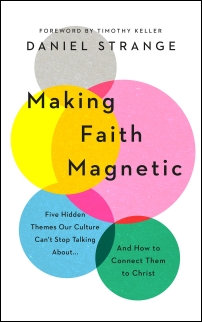Making Faith Magnetic
Dan Strange’s Making Faith Magnetic highlights five of the most compelling questions the world constantly attempts to answer – whether it’s aware of it or not. Split into two parts, Strange unpacks what these questions are before moving on to show that ultimately Christ is the answer. Both parts are crucial in providing believers with a way to engage fruitfully with a culture constantly seeking answers.
Setting the scene
 Strange begins with two introductory chapters that are helpful in framing the rest of the book. They tell the reader the reason for this book and the ‘gearbox’ that propels Strange’s thoughts along. That gearbox is the concept of ‘subversive fulfilment’. This is a term that Strange uses to describe the relationship between the gospel and non-Christian religions. These non-Christian religions are at the same time both incompatible with and parasitic on Christian truth. Therefore, the gospel of Christ both subverts and fulfils all that non-Christian religions strive to be.
Strange begins with two introductory chapters that are helpful in framing the rest of the book. They tell the reader the reason for this book and the ‘gearbox’ that propels Strange’s thoughts along. That gearbox is the concept of ‘subversive fulfilment’. This is a term that Strange uses to describe the relationship between the gospel and non-Christian religions. These non-Christian religions are at the same time both incompatible with and parasitic on Christian truth. Therefore, the gospel of Christ both subverts and fulfils all that non-Christian religions strive to be.
the gospel of Christ both subverts and fulfils all that non-Christian religions strive to be
Strange also elaborates on how humanity suppresses the truth and substitutes God. He likens suppression to ‘someone violently holding a person’s head under the water in order to drown them’ (22). Strange argues that this is seen in our culture, particularly in the stories we tell, ‘whether that’s through boxsets, books, ads, viral videos, or...everyday conversations...all spin our own account of what’s going on in the world, and what matters most’ (23). His use of illustrations (e.g. ‘cosmic hide and seek’ in chapter two) help create a sense of urgency as we move into part one, focused on the magnetic points.
What we yearn for
Leaning on the work of Dutch theologian J.H. Bavinck, Strange outlines the five areas humanity is drawn to ‘magnetically’. These are:
- Totality: A Way to Connect?
- Norm: A Way to Live?
- Deliverance: A Way Out?
- Destiny: A Way to Control?
- Higher Power: A Way Beyond?
Of these five areas, ‘Totality: A Way to Connect?’ stuck out to me the most. Mostly because much of my life I have contemplated what it is to find my place in life to varying degrees. Strange makes this topic of connection digestible by grounding his thoughts with questions that help frame the context. For example, ‘Who are we as human beings? What’s our place in the universe? ... Are we worthless specks, or are we inherently valuable?’ (34). These sorts of questions can inspire a sense of loneliness, but Strange balances this out by exploring the positive contemplations too. This helps make it clear that each magnetic area has many shades within it.
Strange is particularly good at getting at the root each point and giving real-world examples that make it easy to apply
Broadly speaking, Strange is particularly good at getting at the root of each of these magnetic points and giving examples in the real world that make it easy to apply. He shows clearly how though the culture may seemingly dismiss some (if not all) of these pieces, it still yearns for them in some shape or form. Already, when I watch movies or scroll Twitter, I can now pick out how certain magnetic points are in play.
By the time we get to the final magnetic point of ‘Higher Power: A Way Beyond’, to the discerning eye the points intertwine and are in some cases connected. Strange acknowledges this when he writes, ‘these five points connect to each other in interesting ways,’ (23) and ‘these magnetic points are not totally distinct from each other but linked together in various ways’ (73). However, as I read each chapter, they felt stand alone and not connected. I would have loved to have seen Strange more explicitly tease out the connections throughout part one.
Jesus is the answer
With the definitions out the way, part two turns to how Jesus is the one who can fulfil all these magnetic points. He is the subversive fulfilment. I found these chapters particularly encouraging as they were not only very good at showing how and why Jesus is the answer, but additionally, they made it clear how seeing Jesus as the answer was grounded in having a Christian worldview.
Strange is clear throughout that this book is not to a crutch but a signpost that points the reader in the right direction
It was also challenging to think about where perhaps I don’t always see Christ as the answer. And this is what Strange explores in his chapter on ‘magnetic people’. A wise theologian, Harry Blamires, wrote, ‘The Christian mind is the prerequisite of Christian thinking, and Christian thinking is the prerequisite for Christian action’.[1] In this chapter Strange applies this thought well. First he makes it clear that to be magnetic people we need to make sure we hold onto the truth of Christ. ‘If we are not being drawn to Christ, we are being drawn away by something else’ (148). Then through the two headings of ‘Loving Jesus’ and ‘Loving our identity in Jesus’, he clarifies how this should shape us. Setting our eyes on what it is to love Jesus, and find our identity in him, enables us to act in a way that allows us to ‘proclaim…all around us the magnetically attractive hope and certainty that the Lord of history offers’ (158).
I thoroughly enjoyed the book and found it easily digestible. There are obvious perils in writing a book like this, in that readers may be tempted to use it as handbook or crutch that does all their thinking for them. But Strange is clear throughout that this book is not to a crutch but a signpost that points the reader in the right direction. To engage with it fruitfully we must ponder the truth of Christ in our lives by looking always to him in awareness of truth. It is through this truth we can understand why these magnetic points are so compelling and how we can hold out Jesus.
Daniel Strange. Making Faith Magnetic: Five Hidden Themes Our Culture Can't Stop Talking About... And How to Connect Them to Christ (Good Book Company, 2021)
References
[1] Blamires, H. The Christian Mind: How Should a Christian Think? (Regent College Publishing, Vancouver, 2005)



